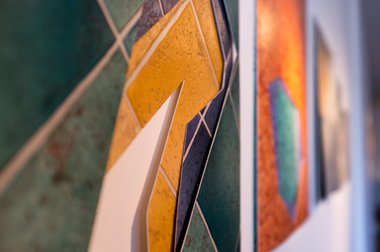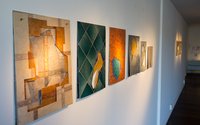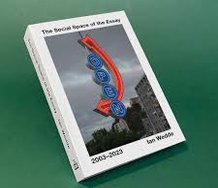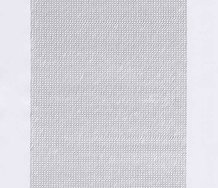Andrew Paul Wood – 7 April, 2012
The title of the exhibition Other Rooms alludes to the domestic spaces that these materials and objects have been translated from. The art works act as a kind of record for the imagined non-sites. However, on another level, the works operate a little like magical doors into what might be thought of as “implied spaces”, unintended consequences and somewhat randomly generated, the places you cannot see in a virtual environment, but which none the less are assumed to be there.
Charlotte Watson is a recent graduate of the Sculpture Department at Canterbury University’s School of Fine Arts. Her exhibition Other Rooms at Chambers@241 gallery is a delightful demonstration of the way the warm, human, and domestic can team up with minimalist abstract formalism to great effect.
Watson’s practice draws on architectonics, furniture, ubiquitous design, interactions with social space, and the relationship between audience perception and movement. I am immediately drawn to the large wall works constructed from old fashioned Formica tabletops which push into the gallery space by means of sharply geometric reliefs. On one level one may enjoy the purely sculptural element. On another, most of us have eaten communally at such a table at one time or another, and hopefully the signifier carries with it warm, nostalgic, and human social resonances. On yet a third level, the painterly decorative effect of the Formica recalls the drips and dribbles of Abstract Expressionism.
Another interesting aspect of these works is the rawness of some of the construction. The bandsawn overshoot of some of the slots and grooves of the construction blend pleasantly with the whole, providing linear highlights which almost suggest something drawn. The domestic reminders take off some of the chill edge of the minimalism and provide a far greater gamut of visual accessibility than such works might have if they were painted Donald Judd white or brown. There is, perhaps, a suggestion of Duchampian Readymade and the objet trouvé meets Frank Stella.
There are other works I find less interesting. Small scale framed pieces of glass to which collages of coloured vinyl have been applied, and a large black and white abstract geometric drawing of positive and negative patterns created by using masking tape, echoed again in the way the drawing has been taped to the wall, the masking tape forming a sort of ad hoc framing device. These are all nice enough in themselves, but there is a bit of a fire sale feeling to them.
The other works in the exhibition are a number of attractive collages constructed from layered and cut-out sheets of linoleum. Some are strikingly colourful and others are a more subtle monochrome palate of greys. The layering and recessed cutting away in these works mirrors the leitmotif of the layered constructivist elements in the tabletop works, and likewise take advantage of the patterning provided by industrial design. One can only assume that they are some kind of riposte to the work of Ilam lecturer Simon Ogden and his lino intaglio.
The title of the exhibition Other Rooms alludes to the domestic spaces that these materials and objects have been translated from. The art works act as a kind of record for the imagined non-sites. However, on another level, the works operate a little like magical doors into what might be thought of as “implied spaces”. Implied spaces are unintended consequences and somewhat randomly generated, the places you cannot see in a virtual environment (such as just around the corner or over the horizon in a computer game), but which none the less are assumed to be there to make the environment logically consistent.
There is also, perhaps, a play on the gallery name. The title actually comes from Truman Capote’s first novel Other Voices, Other Rooms (1948). Written in a similar Southern Gothic style to Carson McCullers, the book’s convoluted plot of isolation and decadence, hinges on what is unconsciously recognised but forgotten, what is distantly viewed, what is disguised, and what is distorted by reflection. This is the relationship that exists between Watson’s materials and resulting objects.
Andrew Paul Wood









 Two Rooms presents a program of residencies and projects
Two Rooms presents a program of residencies and projects Advertising in this column
Advertising in this column



This Discussion has 0 comments.
Comment
Participate
Register to Participate.
Sign in
Sign in to an existing account.